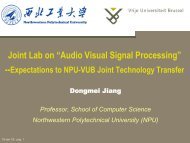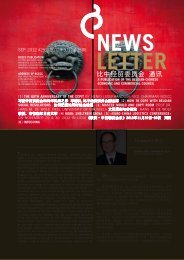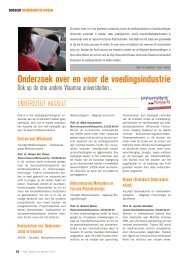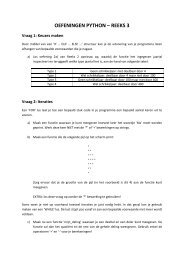least squares theory and design of optimal noise shaping filters
least squares theory and design of optimal noise shaping filters
least squares theory and design of optimal noise shaping filters
Create successful ePaper yourself
Turn your PDF publications into a flip-book with our unique Google optimized e-Paper software.
Verhelst <strong>and</strong> De Koning Least Squares Noise Shaping<br />
It can be noted that digitizing a � ÀÞ tone at ��� �ÀÞ<br />
does indeed result in a sequence with a period <strong>of</strong> 441 samples<br />
explaining the harmonics <strong>of</strong> ÀÞ seen in Fig. 1a.<br />
Most energy is in the fourth harmonic (� ÀÞ). When<br />
the quantization step-size increases, the amount <strong>of</strong> energy<br />
outside this main harmonic increases (Fig. 1b). The use<br />
<strong>of</strong> dither <strong>noise</strong> before quantization works to destroy the<br />
quantized signals harmonicity (Fig. 1c).<br />
With or without dither, the requantization error can be<br />
made minimally audible by proper <strong>noise</strong> <strong>shaping</strong>. It suffices<br />
to change the shape <strong>of</strong> the error spectrum such that<br />
it becomes minimally audible in the presence <strong>of</strong> the audio<br />
signal. The specifications for the <strong>optimal</strong> <strong>noise</strong> <strong>shaping</strong><br />
filter can be determined from the input signal using a psychoacoustic<br />
model. However, these <strong>design</strong> specifications<br />
are time-varying since they depend on the global masking<br />
properties <strong>of</strong> the audio input. Thus, because the <strong>noise</strong><br />
<strong>shaping</strong> filter coefficients need to be updated on-line, it<br />
is crucial that an efficient filter <strong>design</strong> technique be used<br />
that is reliable (for example, that is guaranteed to produce<br />
stable <strong>filters</strong>). In Super Bit Mapping (SBM) [5] for<br />
example, the <strong>optimal</strong> filter coefficients are obtained by<br />
¯ approximating the inverse <strong>of</strong> the desired transfer<br />
function with an LPC synthesis filter (stable allpole<br />
filter)<br />
¯ inverting the LPC synthesis filter, which results in<br />
a minimum phase FIR filter.<br />
More simple <strong>noise</strong> <strong>shaping</strong> with a fixed <strong>noise</strong> <strong>shaping</strong> filter<br />
has also been proposed [2], [3], [5]. There, it is considered<br />
that quantization errors are likely to be most audible<br />
<strong>and</strong> disturbing when the input signal level is low.<br />
Therefore, a fixed <strong>noise</strong> <strong>shaping</strong> can be used that shapes<br />
the error spectrum according to an equi-loudness curve<br />
(the hearing threshold in SBM-1 [5] <strong>and</strong> the 15 phon<br />
curve in F-weighting [3]). While the resulting fixed <strong>noise</strong><br />
<strong>shaping</strong> <strong>filters</strong> lead to a much simpler system, it is clear<br />
that the time varying strategy is preferable from the point<br />
<strong>of</strong> view <strong>of</strong> the overall sound quality: that strategy minimizes<br />
the audibility <strong>of</strong> the error in the presence <strong>of</strong> the<br />
actual audio signal, while the fixed <strong>noise</strong> <strong>shaping</strong> minimizes<br />
the audibility <strong>of</strong> the error itself (when played in<br />
quiet).<br />
In this paper, we present a new <strong>theory</strong> for <strong>optimal</strong> <strong>noise</strong><br />
<strong>shaping</strong> <strong>of</strong> audio signals. This <strong>theory</strong> is based on a Least<br />
Squares interpretation <strong>of</strong> the problem. It provides a shorter<br />
<strong>and</strong> more straightforward pro<strong>of</strong> <strong>of</strong> known properties <strong>of</strong><br />
dithered <strong>and</strong> non-dithered <strong>noise</strong> <strong>shaping</strong>.<br />
Moreover, <strong>and</strong> in contrast with the st<strong>and</strong>ard <strong>theory</strong>, this<br />
new approach does show how <strong>noise</strong> <strong>shaping</strong> <strong>filters</strong> that<br />
attain the theoretical optimum can be <strong>design</strong>ed in practice.<br />
It turns out that the method used in SBM is an optimum<br />
method. Specifically, our <strong>theory</strong> proves that given<br />
an allowed filter order, the filter <strong>design</strong> method <strong>of</strong> SBM<br />
x(n) x’(n)<br />
+<br />
-<br />
H(z)<br />
dither<br />
+<br />
-<br />
e(n)<br />
+<br />
Q<br />
y(n)={<br />
x’(n)+e(n)<br />
x(n)+e’(n)<br />
Figure 2: Dithered requantization with error feedback filter<br />
À Þ <strong>and</strong> requantization error � Ò<br />
will produce the FIR filter that does minimize the perceptually<br />
weighted error spectrum. In fact, we independently<br />
arrived at the very same <strong>design</strong> method in [6].<br />
Finally, we also present results from an experimental <strong>noise</strong><br />
<strong>shaping</strong> system for minimally audible signal requantization<br />
that is based on our filter <strong>design</strong> method <strong>and</strong> a simple<br />
masking model. In listening experiments, this system<br />
was unanimously prefered over the alternatives which included<br />
straightforward requantization, dithered requantization<br />
<strong>and</strong> optimized fixed <strong>noise</strong> <strong>shaping</strong> [2], [3].<br />
The rest <strong>of</strong> this paper is organized as follows. The st<strong>and</strong>ard<br />
<strong>theory</strong> <strong>of</strong> <strong>noise</strong> <strong>shaping</strong> [7] <strong>and</strong> minimally audible<br />
dither signals [2]-[4] is reviewed in section 1. The newly<br />
proposed <strong>theory</strong> <strong>and</strong> the practical <strong>design</strong> method that it<br />
entails are described in section 2. The experiments described<br />
in section 3 show unanimous preference amongst<br />
listeners for our experimental <strong>noise</strong> <strong>shaping</strong> system. Finally,<br />
section 4 concludes the paper.<br />
1. REQUANTIZATION AND NOISE SHAPING<br />
1.1. General concept<br />
While a white <strong>noise</strong> dither signal can already improve<br />
the quality <strong>of</strong> low level requantized signals, <strong>noise</strong> <strong>shaping</strong><br />
can additionally be applied in order to make the requantization<br />
error minimally audible [2]. Fig. 2 illustrates<br />
the general scheme for signal requantization with <strong>noise</strong><br />
<strong>shaping</strong>. In this scheme, Q represents the quantizer <strong>and</strong><br />
À Þ is the error feedback filter. Due to the requantization<br />
error � Ò , the output Ý Ò differs from Ü Ò <strong>and</strong><br />
from Ü Ò . The error feedback filter has to be controlled<br />
such that the difference between Ý Ò <strong>and</strong> Ü Ò becomes<br />
minimally audible.<br />
With signals defined as shown in Fig. 2, <strong>and</strong> using ztransforms,<br />
we have<br />
� Þ � � Þ À Þ � Þ (1)<br />
� Þ � � Þ � Þ � Þ (2)<br />
where � Þ represents quantizer Q’s error signal <strong>and</strong> � Þ<br />
AES 22 Ò� International Conference on Virtual, Synthetic <strong>and</strong> Entertainment Audio 2






